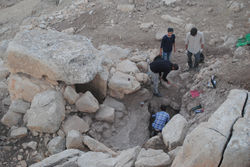Jebel al-Mutawwaq
 |  |  |  |  |
|---|---|---|---|---|
 |
Season 2016
Excavation results of the Spanish-Italian expeditions
The fifth campaign of excavations at Jebel al-Mutawwaq, performed between the 3rd and the 15th of May 2016, enlarged two sectors in Area C: one inside the Great Enclosure, to reach its eastern border (Area C East), the other to the South of Building 131 and Dolmen 534, yet investigated in the 2014-2015 season (Area C South). This second sector in Area C was opened in order to excavate another Dolmen (number 535), located on the southern cliff of the mountain, just few meter South of Dolmen 534 and of the south-eastern corner of the Great Enclosure.
Another operation performed in the 2016 campaign was the opening of another area of excavation (Area D) located in the northern part of the Early Bronze Age I village central sector and yet identified by an electrical resistivity and conductivity analysis performed during 2015.Area D is located on the southern slope of the mountain, around one hundred meter north west from the Great Enclosure. In Area D two trenches of 2x5 m and 3x5 m has been excavated. The second has been then enlarged for other 6 square meters to the South. Here, a long wall (W.161), oriented northeast - southwest, preserved for 50 cm wide and built with a single raw of stones, in some place preserved for two courses, has been discovered. The wall runs along the entire length of the trench and its connection with other structures or its function as part of a private building was not yet discovered. Area C East, where in the past seasons the large open building called Great Enclosure start to be excavated, was enlarged to the east (15x 15 m) of has been enlarged toward East, reaching its northeastern corner (W. 101).
The main aim was to identify the possible function of this building and recovering materials from the original floor of use, yet identified in 2015 as the natural bedrock of the mountain. Excavations identified the inner and the outer faces of the wall, lined with large stone bulks, filled inside with rubbles and smaller stones. The wall was laid directly on the bedrock, leveled in this point with a layer of rubbles and compact earth. Few diagnostic sherds, such as flat bases of large storage jars, orange paste, hand-made, recovered in the foundation of W. 101 in this point, permit to confirm the dating of the construction of the Great Enclosure to the Early Bronze Age I, the main period of use of the Jebel al-Mutawwaq village.
In Area C South a dolmen (no. 535) located on the southern cliff of the mountain was investigated, opening a trench of 10 x 5 m. The dolmen appears as one of the larger megalithic structure since now excavated, surrounded by an apsidal wall, circular on the back with the two lateral side straight. From the beginning of the work it was clear that the inner chamber of the structure has been sacked from behind. The back slab was collapsed, but the good state of preservation of the lower layer inside the chamber allows to recover some sherds and few human bones. These findings seems to date the first use of the dolmen to the Early Bronze Age IB, the same period of the Dolmen 534. In the front of the dolmen an external floor with a circular installation was discovered, 1.5 m higher than the level of the floor slab, relative to a second later use of the structure. Pottery coming from this phase can be dated to the Early Bronze Age IB-II and consist of few sherds of a small bowl with disk base and a red burnished carinated platter with inturned rim. Excavations of Dolmen 535 will continue in the future 2017 campaign, in order to reach the floor level of the ante-chamber of the dolmen.

Describe your image

Describe your image

Describe your image

Describe your image